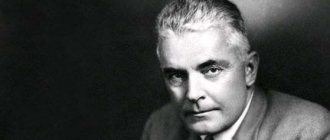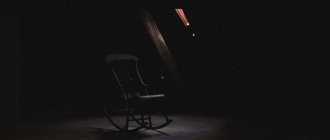Behaviorism is a movement in psychological science that determined the image of American psychology in the 20th century, radically reorganizing the entire concept of views about the psyche. His vision formulated an expression in which the subject of psychological science is behavior, and not consciousness. Where, in fact, do “legs grow” from, since translated from English. "behavior" literally means "behavior."
Due to the fact that at that time it was customary to establish an equal sign between such concepts as psyche and consciousness (mental processes included those processes that began and ended in consciousness), a version appeared that by eliminating consciousness, behaviorism, thus, removes psyche.
The real essence of this event, associated with the emergence and rapid formation of the behaviorist movement, was different and was not contained in the annihilation of the psyche, but in a change in its definition.
Within the framework of this article, such a psychological movement as Behaviorism is described. We will learn about the scientists who were at the origins of this trend, about the experiments they conducted, the theories and hypotheses they put forward, as well as about the birth of Neobihiveorism.
Behaviorism and Neobehaviorism in psychology
- 1.History of behaviorism 1.1.Thorndike
- 1.2.Trial and error method
- 1.3.Evolutionary theory
- 3.1.Behaviourism in Russia
- 4.1.Formula of behaviorism
- 5.1.Emotions according to Watson
- Very simple about the subconscious
- Dementia - what is this disease?
- Schizoid and Schizoid: Signs and Causes
- Butterfly Effect - What is it?
- Paraphrenic syndrome in schizophrenia. Clinical picture
History of behaviorism
Thorndike
Edward Lee Thorndike is considered the first founder of such a movement as behaviorism.
Although he himself did not consider himself a behaviorist, but referred to him as a “connectionist”, which is translated from English. means “connection.” However, people conducting research and their theories must be judged not according to what they call themselves, but according to their significance in the formation of knowledge. The works of Edward Lee Thorndike became precisely the first step in creating the theory of behaviorism. Thorndike explained his own conclusion in his doctoral dissertation, “The Intelligence of Animals,” written in 1898. Experimental study of associative processes in animals." Thorndike used the classic definitions - “intelligence”, “associative processes”, but their content was different.
Trial and error method
Hobbes once argued that human mental abilities are of an associative nature.
The fact that mental abilities guarantee the successful adaptation of an animal to its environment was generally accepted after Spencer. However, Thorndike was the first to show through experiment that the essence of mental abilities and their role have every chance of being studied, and they can also be assessed in the absence of an idea or by another action of the mind.
Association no longer meant the relationship between thoughts or thoughts and their movement, as in previously created associative concepts, but between movements and situations. The complete learning process was described in objective terms. To regulate behavior, Thorndike used Wen's "trial and error" method.
The selection of this particular method as a starting point had the deepest methodological basis. He marked the reorientation of the idea of psychology into the newest method of deterministic explanation of its own subjects. Darwin deliberately did not concentrate the importance of “trial and error” in any way; this idea, of course, was one of the premises of his theory of evolution.
Since probable methods of response in constantly changing environmental conditions are not previously taken into account in the structure and methods of action of the organism, the regulation of this action with the environment is implemented only on a probabilistic basis.
Evolutionary theory
This theory in the development of behaviorism caused the introduction of a probabilistic condition that functions with the same kind of immutability as mechanical causation.
The probability of “no longer possible” had to be considered as a subjective idea (the result of ignorance of factors, according to Spinoza’s statement). The rule of “trial, error and unintentional success” explains, in accordance with Thorndike, the acquisition by living organisms of new configurations of behavior in absolutely all degrees of its formation. The advantage of this principle is undoubtedly when comparing it with the classical (mechanical) reflex circuit.
Reflex, in his pre-Sechenov view, meant a fixed process, the action of which is determined in such a way that the concepts of the nervous system are strictly fixed by methods. It was simply unrealistic to explain the adaptability of the body’s interactions and its learning ability with this definition.
Edward Lee Thorndike perceived the initial period of a motor act not as an external push that launched a physical machine with prepared methods of response into the process, but as a problematic situation, meaning such conditions in the environment, for adaptation to which the body does not have a motor response, but must create it with its own efforts.
Thus, the relationship between “ situation and reaction”
"In contrast to the reflex - in its interpretation exclusively known to Thorndike, it was characterized by the following properties:
- The initial section is the problem environment (situation). The body resists it as a whole. He functions rapidly in search of choice. It is learned through the method of exercise.
The brains of employed people recover faster after a stroke
Neobehaviorism.
B.F. Skinner supported Watson's ideas. The psychologist agreed that science should rely only on what is objective. The scientist saw no point in conducting tests that do not have objective confirmation. He was inclined to study the mechanisms of behavior, and the main goal of behaviorism in Skinner's psychology was to “program” human behavior to produce a certain result.
For programming, Skinner chose the carrot method , he was sure that a positive incentive was more effective. Further research confirmed this. The psychologist did not take into account the goals of education and psychoanalytic sociology. He put behaviorism at the forefront, believing that if it does not answer the question posed, then there is no such answer in nature.
Take the test: child, adult, parent
Skinner put forward two interesting theories:
- About the dangers of spreading creativity . If we assume that the designer who creates sketches has more creative potential than the seamstress who creates clothes based on them, then this is normal. But if all people had the same creative potential, who would create clothes? That is, it turns out that equality in the development of creativity brings more disadvantages than advantages.
- On the control of a slave over his slave owner . It is obvious that a slave owner is able to control a slave. If a slave fulfills orders, he is encouraged, and if he does not fulfill them, he is punished. But the slave also has a minimum level of control, since he himself chooses whether to obey him or not, and therefore influences the degree of punishment or reward.
Skinner argued that a person's personality is shaped by society.
Situation – Reaction
The consciousness of Thorndike's approach, according to a comparison of the approach of John Dewey and other scientific minds of Chicago, is undeniable, since the conscious desire for a goal was perceived by them not as a phenomenon that needs clarification, but as a causal basis.
However, Thorndike, having eliminated the conscious desire to achieve a goal, restrained the thought of the active actions of the organism, the significance of which lies in solving difficulties in order to adapt to the environment. Thus, Thorndike greatly expanded the field of psychological science. He revealed that it extends far beyond the boundaries of reason.
Previously, it was believed that a specialist in the field of psychology beyond these boundaries could only be interested in unconscious actions hidden in the “repository of the soul.” Thorndike radically changed direction. The field of psychological science turns out to be the connection between an organism and its environment.
In the past, psychology claimed that connections emerged among the paradoxes of the mind; it called them associations. Past physiology stated that relationships arise between the excitation of receptors and the opposing movement of muscles. They were called reflexes.
According to Thorndike, connexation is the relationship between reaction and situation
. There is no doubt that this is a new component. In the words of another psychological science, connection is a component of behavior. Of course, Thorndike did not use the definition of “behavior” at that time. He claimed intelligence and learning.
However, Descartes in his time did not call the reaction he discovered a “reflex,” and Hobbes, being the progenitor of the associative theory, did not use such a combination of words as “association of ideas,” invented by Locke 50 years after his discovery. The idea matures before its definition.
The work of Edward Lee Thorndike would not have had the significance of a pioneer in the field of psychology if it had not been for the discovery of new direct psychological laws.
However, no less clearly does he see the insufficiency of behaviorist methods in the project of explaining human behavior. The regulation of which occurs according to a different type than was imagined by Thorndike and all, without exception, further adherents of objective psychological science, who considered the science of learning to be common to both man and other living creatures.
This kind of aspect has given rise to the latest configuration of reductionism. The inherent human patterns of behavior, which have reasons of a socio-historical nature, were reduced to a biological degree of determination, which, in turn, contributed to the loss of the opportunity to study these patterns in the corresponding scientific judgments.
Thorndike, more than anyone else, paved the way for the emergence of such a movement in psychology as behaviorism. At the same time, as noted earlier, he in no way considered himself to be in this direction; in his own explanations of the actions of learning, he used ideas that the subsequent emergence of behaviorism demanded to be banished from psychological science
Such definitions included, first of all, the field of psychology in its classical presentation (in particular, definitions of the states of discomfort and contentment experienced by the body when interrelations appear among motor reactions and external conditions), and secondly, this concerned neurophysiology (in particular, the “law of readiness "which, according to Thorndike, implies changes in the ability to carry out impulses).
The behaviorist concept did not allow the researcher of behavior to resort to what the subject feels and to conditions of a physiological nature.
MOTIVATION
Maintaining
Among the numerous directions and theories of modern psychology in educational psychology, the ideas formulated by representatives of neobehaviorism are important.
Neobehaviorism is a trend in American psychology that arose in the 30s. XX century Having accepted the main postulate of behaviorism, according to which the subject of psychology is the objectively observable reactions of the body to environmental stimuli, neobehaviorism supplemented it with the concept of “intermediate variables” as factors that serve as a mediating link between the influence of stimuli and the response muscle movements. Following the methodology of operationalism, neobehaviorism believed that the content of this concept (denoting “unobservable” cognitive and motivational components of behavior) is revealed in laboratory experiments according to characteristics determined through the operations of the researcher. neobehaviorism testified to the crisis of “classical” behaviorism, which was unable to explain the integrity and appropriateness of behavior, its regulation by information about the surrounding world and its dependence on the needs of the body. Using the ideas of Gestalt psychology and Freudianism (E. C. Tolman), as well as Pavlovian doctrine of higher nervous activity (K. L. Hull), Neobehaviorism sought to overcome the limitations of the original behaviorist doctrine, retaining, however, its main focus on the biologization of the human psyche [1 ].
This direction leads us to understand the mechanisms of formation of readiness for self-education at various stages of student personality development.
Neobehaviorism turns out to be significant at the initial stage of its formation, when the degree of internalization is low. What is needed here is clarity and understanding of what the teacher does and what the student himself should do. At the same time, the stability of motivation is constantly stimulated both from the outside, by objects and subjects of the pedagogical process, and from the inside - by the individual himself.
Vast explanatory and psychological-methodological material is provided by neo-behaviourism, which introduces into the arsenal the concepts of “cognition”, “need”, “goal” previously denied by behaviorists, for teaching rules, norms, techniques, technologies for knowledge of the subject area, for creating and using testing programs that allow the student to master the conceptual apparatus of the problem being studied [3].
The purpose of this work is to examine neobehaviorism and its main ideas. To achieve this goal, it is necessary to solve a number of problems, namely: consideration of the development of this psychological direction in the context of its main representatives. Which will give us the opportunity to delve into the basic ideas of neo-behaviorism and trace their development.
Watson's behaviorism
The leader, based on the theory of behaviorism, was D. B. Watson.
His scientific life story is moral in the sense that it demonstrates, just as in the formation of an individual prospector, the influences that established the formation of the main thoughts of the trend are reflected in full. Having defended his dissertation on psychological science at the University of Chicago, Watson has been working at the Johns Hopkins University in Baltimore since 1908, where he heads and directs the department and laboratory of experimental psychology. The article he published in 1913, “Psychology from the Behaviorist’s Point of View,” is regarded as a kind of reversal of the latest trend.
Shortly after the article, Watson published the book “Behavior: An Introduction to Comparative Psychology,” where for the first time since the creation of psychological science and throughout its history, the assertion that consciousness is the subject of study of this science was categorically rejected.
Behaviorism in Russia
The slogan of behaviorism becomes the idea of behavior as a fairly contemplated concept of the body's reactions to external and internal and internal impulses.
This idea originated in Russian science in the works of such scientists as: I.M. Sechenova, I.P. Pavlova and V.M. Bekhterev. They argued that the scope of psychological activity is in no way limited to the actions of the subject’s mind, cognizable through introspection, since the presence of such an interpretation of mental consciousness inevitably divided the organism into consciousness (soul) and body (matter). As a result, consciousness was separated from external reality, closed in the environment of personal phenomena (excitement), establishing it outside the actual interconnection of earthly objects and involvement in the process of physical actions.
Without recognizing such a judgment, Russian scientists have found a bold way to study the relationship of an entire organism with the environment, guided by specific methods, while the organism, in turn, is explained in accordance with its external and internal manifestations. This aspect denoted the future in order to identify the conditions for the interaction of the whole organism with the environment and the factors that determine the dynamics of this interaction. It was planned that understanding the factors would make it possible to implement in psychology the standard of other sciences with their slogan “foresight and guidance.” This newest concept suited the needs of the period.
The long-standing subjective psychological science has everywhere revealed its own inconsistency. This was clearly demonstrated by experiments conducted on animals, which, in turn, were the main subject of study by psychologists on the American continent. Reflections on consciousness and what happens in it in the animal when performing certain assigned tasks during the experiment turned out to be inconclusive. As a result, Watson came to the conclusion that observations of the state of consciousness are of little use to a specialist in the field of psychology. Only by renouncing the data of internal research and observations, he assured, would psychology be an impartial and true science.
Sleep learning: is it possible?
Neobehaviorism research methods. The Scientific Method and Neo-Behaviorism
⇐ Previous Page 30 of 49 Next ⇒
Psychology in the 1920s. represented a huge variety of areas, and this was especially obvious in the USA, simply because there were the most professional psychologists there. There was a huge distance between psychology as a natural science - an academic discipline - and psychology as an applied discipline in the service of society - as well as between experimenters and testologists. There were psychologists who dealt with popular problems - such as raising children - and those who studied the processes of sensation and perception, accessible only to the initiated. There was no agreement on basic concepts or the need for a general theory. Psychologists who worked with an eye on the physical sciences, which seemed integral, could not be satisfied with this situation.
In the second half of the 1920s. There were several responses to the current situation. Boring, for example, published a major study entitled A History of Experimental Psychology (1929) to build a genealogy of experimental psychology and show that it was a legitimate candidate for the title of science. For half a century, this book had a decisive influence on ideas about psychology and its development, facilitated by the important position that Boring held at Harvard University between 1922 and 1968. and the American Psychological Association. Carl Murchison (1887–1961), head of the psychology department at Clark University, Massachusetts, in 1925 and 1930. compiled original collections of manifestos in which the positions of about a dozen different schools of theoretical psychology were compared. In 1931, Woodworth of Columbia University published Contemporary Schools of Psychology, and the teaching of “systems and theories” in psychology became a fixture in university curricula. Edna Heidbreder (1890–1985), who taught at Wellesley College, published a widely used textbook titled Seven Psychologies (1933). Nevertheless, psychologists considered the study of the history and systems of psychology to be a weak substitute for a unified theory.
Conditioned reflex
The unified direction of the transition from reason to action, from an individual way of considering the psyche to an impartial one, was monitored in different parts of the scientific front.
Having read Bekhterev’s book “Objective Psychology,” Watson was completely confident in the judgment that the conditioned reflex is the main criterion for assessing behavior. Having familiarized himself with the works of Pavlov, Watson was firmly convinced that the conditioned reflex itself is considered to be precisely the source for the development of skills, according to the construction of difficult movements from ordinary ones, and, in addition, for various learning configurations, including those of an emotionally charged nature.
Behaviorism formula
Being influenced by positivism, Watson argued that the only thing that really matters is, perhaps, direct observation.
For this reason, according to his project, all the actions of the subject and his behavior must necessarily be interpreted on the basis of the relationships contemplated by the influence of physical stimuli on the body and its contemplated reactions in response to these stimuli. As a result, Watson derived the formula adopted by behaviorism: “stimulus-response”
(SR). It followed from this that psychological science must eliminate the sequential change of states that occur between the components of a given formula, whether nervous or mental processes, from its own hypotheses and explanations.
Since various forms of physical interactions were recognized as exclusively valid in behavior, Watson replaced all, without exception, classical views on psychological phenomena with their motor equivalents. The interdependence of various psychological functions on motor initiative that existed was thoroughly determined by experimental psychology at that time. This affected, for example, the connections between visual perception from the movement of the muscles of the visual organ, emotions from physical changes, thinking from the speech apparatus, etc.
It's all about movement
Watson used these data to confirm that specific muscular movements have every chance of being a substitute for individual psychological actions.
Based on this kind of premise, Watson explained the formation of intellectual initiative. Arguments were given that the individual thinks with his muscles. Children's speech emerges from random sounds. When combining any object with a sound pronounced by an adult, the object becomes the meaning of the phrase. Over time, children's external speech transforms into a whisper, after which they pronounce the words mentally. Such silent singing or, in other words, speech within oneself is nothing more than thinking.
Absolutely all reactions, both mental and associated with emotions, are possible, according to Watson's judgment, to be controlled. Psychological formation comes down to learning, in other words, to acquiring knowledge, skills and abilities that are not only intentionally created, but also appear spontaneously. That is, learning has a more extensive concept compared to teaching, since it contains knowledge deliberately developed during training. It follows from this that the study of the formation of the psyche leads to the study of the development of behavior, the relationships between stimuli and the reactions (SR) that appear in their base.
Psychology: what you need to know about it
Basic Ideas and Personality Theory
The behavioristic approach implies that personality is the experience acquired by a person over the entire period of life. Those. personality is a set of studied behaviors. And behavior in this regard is an individual and predictable pattern formed under external influence.
The classic scheme can be simplified to the formula “stimulus + response = behaviorism” . But Thorndike supplemented this formula with the concept of “reinforcement.”
Reinforcement can be with a “plus” sign, such as praise, encouragement, reward, achievement of an expected result, etc. But it can also be with a minus sign: pain, disappointment, criticism, punishment, etc.
Behavior is based on the fact that a person strives for positive reinforcement or wants to avoid its negative version.
Personality in this case becomes a set of tools that a person has in relation to reaction (conscious control of regulated instincts, skills, plasticity and the ability to retain skills).
It follows from this that personality is a system of organized and stable skills.
The behaviorist approach views a person as the result of reactions, actions and learning .
Behaviorism and the role of the psyche
Adhering to this view of the psyche, behaviorists concluded that its formation takes place in childhood and depends on factors such as the society surrounding the child, the quality and conditions of his life, namely on the stimuli that the environment provides him.
For this reason, they rejected the idea of age periodization, since they believed that there are no absolute patterns of formation for all children in this age range. This was confirmed by studies of the learning of children of different ages, with a specific learning goal set, even children of two and three years old could not only read and write, but even master typing skills. Based on this, behaviorists concluded that the sphere of influence in which the child is located affects his mental formation.
However, the impracticability of age-based periodization in no way excluded, from their judgment, the need to create a multifunctional periodization that would make it possible to determine the boundaries of learning the development of specific experience. For these reasons, the stages of developing a game, learning to read and write, or swimming are considered multifunctional periodization.
Emotions according to Watson
Evidence for the lifetime development of key psychological actions was provided by Watson in his experiments related to the development of emotions.
At first glance, James's assumptions about the primacy of physical changes and the secondary nature of psychological states should have satisfied Watson. However, he radically denied them, based on the fact that the very understanding of the subjective, experienced must be removed from psychological science. According to Watson, emotions contain nothing but internal changes and external expressions. However, he saw the main thing in something else - in the ability to manage emotional behavior according to an established plan.
Experiments performed
Watson experimentally argued that it is possible to create a fear response to a stimulus that belongs to something.
In his experiment, children were shown a bunny, which they, in turn, tried to stroke and pick up, but at the very second when the bunny was in the child’s hands, it was exposed to an electric discharge. As a result, the child threw the bunny away from him and began to cry. The experiment was repeated, and when the bunny was demonstrated 3–4 times, including at a distant distance, it initiated fear in most children. After this negative emotion was recorded, Watson sought to once again change the child’s emotional background in relation to the bunny, forming their interest and feeling of love for him. This time the child was shown a bunny while eating delicious food. At first, when they saw him, the children interrupted their meal and began to cry.
However, after some time, realizing that the bunny was sitting calmly at the end of the room and was not trying to get closer to him, and that sweets (chocolate, candies, popsicles) were very close, the child stopped crying. When the child stopped responding with sobs to the appearance of the hare at the end of the room, the researcher began to move it closer and closer to the child while at the same time adding sweets and goodies to his plate. Over time, the children stopped concentrating their attention on the bunny and, in the end, when it was near the plate, they did not react to it in any way, and some even tried to feed it and pet it. In a similar way, Watson argued that emotions can be controlled and managed.
People who have frequent outbursts of anger are not actually as smart as they think they are.
Neobehaviorism in foreign social psychology
tags:
Social, Learning, Model, Psychology, Reaction, Observer, Behavior, Dollar
BSU, Faculty of Humanities,
Specialty "Psychology",
4th year, group 2
LECTURE NOTES
Well
"Foreign social psychology"
Subject
: “Neo-behaviourism in foreign social psychology”
The beginning of the formation of social psychology occurred at a time when behavioristic principles dominated in psychology. Currently, behaviorism in social psychology uses those variants of this movement that are associated with neobehaviorism. Therefore, the topic of neobehaviorism comes first (after the overview and introductory) in the course of foreign social psychology and is important for further understanding and study of the course.
Number of hours
: 2 out of 4
Audience:
The audience of the lecture are 3rd year students majoring in Psychology. A fairly prepared audience, they attended the courses “History of Psychology” and “History of Social Psychology”. Consequently, students are familiar with the behaviorist direction and have a general understanding of the topic of the lecture.
Target
: to form in students the necessary knowledge about neobehaviorism as a direction in foreign social psychology.
7 pages, 3143 words
4 psychology lectures
... Continuation of a series of articles by the author from a series on psychology lectures. Based on psychological facts, they describe and classify... a lecture on the laws is given in order to balance actionological thinking [1, p. 11]: the problem of students’ attention known in psychology. 115]. ORGANIZATION In psychology, attention is defined as follows: 1. Involuntary attention INVOLUTIONARY, ARBITRARY is divided as follows: ...
Tasks
: 1) Smoothly introduce students to the topic of neo-behaviorism;
2) Update their previously acquired knowledge on this topic;
3) Provide high-quality knowledge on the topic of the lecture, highlighting the main points, giving clear examples;
4) Reveal the fundamental provisions of the content that are difficult for students to understand and assimilate;
5) Obtain feedback from students as evidence of their involvement in the lecture process and understanding of the topic;
6) Systematize the learned material in the form of a brief summary after each question;
7) Monitor proper note-taking during the lecture;
 To develop a culture of behavior in students during lectures;
To develop a culture of behavior in students during lectures;
Organizational form of the lecture:
monologue statement addressing the audience
Main questions of the lecture
:
- The problem of behaviorism and neobehaviorism in social psychology.
- Research on Learning (Neil Miller, John Dollard, Albert Bandura)
- Frustration-aggression theory (Neil Miller, John Dollard).
- The theory of interpersonal interaction as exchange (Harold Kelly, John Thibault).
Literature used in preparation
:
- Andreeva G.M., Bogomolova N.N., Petrovskaya L.A. Foreign social psychology of the twentieth century. Theoretical approaches
- Semechkin N.I. Social psychology at the turn of the century. Part I
- Andreeva G. Social psychology
Literature for students
:
7 pages, 3143 words
4 psychology lectures
... Author of more than 40 publications Continuation of the series of articles by the author from the series on psychology lectures. Based on psychological facts, methods for organizing the attention of listeners are described and classified. ... sometimes blanks intended for psychological introduction are useful. You cannot hope that students' attention will be sustained throughout the lecture. If the topic is difficult to understand, then fluctuations in attention...
- Andreeva G.M., Bogomolova N.N., Petrovskaya L.A. Foreign social psychology of the twentieth century. Theoretical approaches
- Semechkin N.I. Social psychology at the turn of the century. Part I
- Yanchuk V. A. Introduction to modern social psychology
- Watson D. Behavior as a subject of psychology (behaviorism and neobehaviorism) (article)
- Shultz D., Shultz S. History of modern psychology
Equipment
: printed lecture text 1 copy, chalk, blackboard. Students must have notes and a pen with them.
Lecture text
:
We will begin to study the course of foreign social psychology with neobehaviorism.
So, our first question:
- The problem of behaviorism and neobehaviorism in social psychology.
As you remember, the beginning of the formation of social psychology occurred at a time when behavioristic principles dominated in psychology. And since today behaviorism in social psychology uses those variants of this movement that are associated with neobehaviorism, we will study it (neobehaviorism).
The basis of neobehaviorism is behaviorism.
As you remember, the concept of “behaviorism” comes from the English “behavior”,
which translates as "behavior
".
Therefore, behavioral psychologists studied behavior.
And because They set themselves the task of not only learning to understand and predict behavior, but also to form, develop “correct” or “necessary” behavior, and ultimately manage it, then the main theoretical problem of behaviorism became the teaching
of this or that behavior.
4 pp., 1595 words
Psychology 35
... the environment shapes behavior through the totality of the body's reactions to stimuli and reinforcements. 1.4. The method of introspection in psychology is called introspection. ... psychology; In – behaviorism; G – cognitive psychology. 1.24. The “S–R” scheme emphasizes ... A - on an objective description of behavior; B – uselessness of the concept of consciousness; B – correspondence between reaction and stimulus; D – dominance of stimuli in behavior. ...
Do you remember what learning is?
(Learning
- in a broad sense - a class of psychological processes that ensure the formation of new adaptive reactions.
Learning
- in the narrow sense - the process and result of acquiring individual experience)
Hence the name of theories that study this process - learning theories. These theories primarily analyze the relationship between stimulus and response.
Let's remember what a “stimulus” is and what a “reaction” is.
(Stimulus –
is any event, external or internal, that changes the behavior of a person or animal (organism).
Reaction –
this is the change in behavior that follows in response to the stimulus).
Thus, behavior in behaviorism is determined by the simple formula
:
S
→ R (on the board)
where, S –
stimulus, R
–
response.
Example: schoolchildren's studies.
The parents said, “Just try to bring a deuce” (stimulus). The student wrote the work well (reaction).
Behavioral scientists,
practically not interested in what happens in the interval between stimulus and response, that is, the mental and mental aspects of behavior.
They are only interested in the preceding event (stimulus) and the subsequent one (reaction), i.e. cause and investigation. ( Example: for them it has no practical significance what a person thinks and experiences when making plans for the next day)
. That is, the body is a kind of “black box” where you can only record what is at the input and what is at the output.
There is another important concept in this theory - reinforcement. Reinforcements –
This is an influence that increases or decreases the likelihood of a repetition of the reaction that preceded it.
4 pp., 1649 words
Expressive behavior
... and a low degree of variability (physiognomic components of expression). The psychology of expressive behavior examines a wide range of means by which a person expresses himself or... Moreover, expressive behavior, as a rule, becomes part of this state, for example, stupid... a decision has been made, the conversation is boring, something surprised or shocked...; Involuntary reactions These re
Do you remember what reinforcement can be?
(Positive, negative, neutral).
What does positive reinforcement lead to? Negative? Neutral?
Positive
(or
positive)
, reinforcement increases the likelihood of a response being repeated.
Negative reinforcement –
helps eliminate the behavior.
The body strives to avoid repeating such actions. Neutral reinforcement
– does not influence the manifestation of this behavior in the future.
(An example with preparation for an exam at the last moment and a grade - “very good”, “very bad”; the teacher said that the student looks good today).
Reinforcement is the main factor in all learning.
Do you know who first spoke about learning?
The key principle of learning was first established by Edward Lee Thorndike and Ivan Petrovich Pavlov. According to E.L. Thorndike and I.P. Pavlov, animals and people learn by trial and error. When a successful model of behavior that satisfies the emerging need is found, it is then repeated many times and thus reinforced.
Since the key (and, as it seemed then), the only factor in learning was found, further research by behaviorist-oriented scientists was directed primarily at the study of reinforcement.
Neo-behaviourism - the study of learning.
The foundations of neobehaviorism were laid by Edward Chase Tolman
. He took into account not only the external behavior of the organism according to the “stimulus-response” scheme, but also took into account the processes occurring in the organism itself.
Next in neo-behaviorism was Clark Leonard Hull.
He was engaged in theoretical and experimental studies of behavior and learning and was also influenced by the ideas of I. Pavlov and E. Thorndike. It was thanks to K. Hull that the neobehaviorist model of behavior was finally formulated, which began to be expressed as
6 pages, 2912 words
Behavior as a psychophysiological phenomenon
...processes known only to man himself. By externally manifested behavior we mean actions, speech, and physiological reactions that are obvious to an outside observer. By mental, internal, human behavior we mean human habits: habits of perception, emotional and...
S – O – R (on the board)
those. stimulus – organism – reaction. Example: parents, before getting a student to do well in school, think about “what will happen in the psyche of our child if, in order to achieve good grades, we put them in the corner for every bad mark??”
K. Hull insisted that without studying the unobservable processes occurring in the body, which, nevertheless, can be objectively described, behavior cannot be understood. He considered the most effective reinforcement to be that reinforcement that gives the body the opportunity to satisfy its needs.
Another problem related to learning and reinforcement was studied by Burres Frederick Skinner
.
He came up with the idea of operant conditioning
.
In contrast to the principle of classical conditioning according to I.P. Pavlov: Stimulus -> Reaction, he developed the principle: Reaction -> Stimulus.
The essence of learning according to this scheme is that instead of offering a stimulus that causes a certain reaction, the experimenter, observing the organism, waits for the random occurrence of a reaction in the direction of interest to him. And its manifestation is immediately reinforced.
Bottom line
The basic ideas of learning theories remain important today and influence modern social psychologists. But in general, social psychology has long gone beyond simple stimulus-response models in the study of human behavior. And the main distinguishing feature of current theories of learning is their interest in the intrapsychic processes occurring in the body. Those. Scientists study not only stimuli and reactions, but also the person himself involved in the learning process. Moreover, at present, the focus of researchers’ interest is increasingly shifting to human cognitive and mental activity, i.e., to the intermediate link between stimulus and response.
Our second question:
- Research on learning (Miller, Dollard, Bandura)
In this question we will be introduced to the theories of neo-behaviorism that have had the greatest influence on modern social psychology.
9 pages, 4453 words
Chapter 1. Deviant behavior as a problem of social work
...instructional and methodological material. Chapter 1. Deviant behavior as a problem of social work 1.1 The concept and causes of deviant behavior The assessment of any behavior involves comparing it with what ... in minors the works of N.A. Dremova, G.L. Isurina are devoted. Forms of deviant behavior are very diverse. [3, pp.48-50] Social deviations can be classified on a number of grounds: - in ...
Miller and Dollard's approach
Modern theories of social learning originate from the names of Neil Miller
and
John Dollard
(first half of the 20th century), who drew attention to the phenomenon
of imitation
(or
imitation)
in the process of social learning.
Imitation
is the reproduction of someone else's actions.
For reference:
the problem of imitation belongs to the circle of the first problems in the emerging social psychology at the turn of the 19th-20th centuries. The increased interest of psychologists in this problem is due to the fact that imitation is the most important mechanism from which such social phenomena as socialization and conformity originate.
Miller and Dollard, in Social Learning and Imitation, abandon the old tradition of defining imitation as an instinct. They view imitation as an object of instrumental learning.
Do you know what instrumental learning is?
(
Instrumental learning
is learning that occurs: - 1. due to the spontaneous generation by the body of many different reactions to the same stimulus or situation; - 2. with the subsequent reinforcement of only those reactions that turned out to be the most successful in terms of the effect obtained, i.e. e. by trial and error).
A simple example: a rake
.
Also, Miller and Dollard named 4 fundamental factors of all learning:
- Drive
- Signal
- Reaction
- Reward (reinforcement)
We have already studied what incentive and reward are. Let's look at concepts that are new to us.
Drive
- a complex of influences that direct human behavior to satisfy the basic need at a given time.
10 pages, 4603 words
Features of speech behavior in social interaction
... speech and its addressee than speech in interpersonal interaction. For verbal behavior in social interaction, the main importance is the verbal design of the social-role status of the participants in communication; it is enough... to rethink what was previously said and understood, by correlating one’s “model” of the understood with the real facts and line of behavior of the interlocutor. This “work” is also instantaneous, simultaneous and...
Signal
- an indicator of the manifestation of a certain behavior, indicating the circumstances of the stimulus.
Example: the presence of a teacher in the classroom acts as a certain signal about the need for students to take appropriate actions.
Now let's get back to imitation. The authors introduce, among other secondary urges, the urge to imitate, imitate
.
In their opinion, one of the most important classes of signals in a social learning situation is the behavior of others. By observing open behavioral responses-patterns to certain signals, some of which lead to reward, while others do not, the observer acquires a certain hierarchy of signal values. Example: a new employee at a company is observing his colleagues.
One of them argues with his superiors all the time and tries to do everything his own way, while the other agrees with his superiors in everything and does as ordered. One of them was soon fired, and the other was promoted. A new employee immediately develops an understanding of how best to behave with his superiors. Attaching great importance to the mechanism of learning through trial and error, Miller and Dollard draw attention to the opportunity, through imitation, to limit trial and error, to get closer to the right path through observing the behavior of others.
So, in general, the learning situation, including imitation, represents, according to Miller and Dollard, the following chain:
signal
→
internal reaction
→
drive
→
external reaction
→
reward (on the board)
3 options for using the term “imitation”:
1. To denote "identical" behavior
. Such behavior often only superficially looks like imitation, but in reality it can represent the same reactions to the same stimuli in two individuals, and each of them, regardless of the other, has learned such a response, i.e. “identical” behavior may or may not be the result of imitation.
2. «Couple-dependent behavior
. It often occurs in dyadic interactions in which the behavior of one party, who is usually older or more skilled than the other, serves as a signal for the other, the observer (the observer is rewarded for the same response as the model).
28 pp., 13551 words
Deviant behavior as a social phenomenon
... moral vices, deviations from principles, norms of morality and law. Deviant behavior, understood as a violation of social norms, has become widespread in recent years. It seems to me... people have the opportunity to express their deviant behavior. Therefore, this problem is in the center of attention of sociologists, social psychologists, doctors, law enforcement officials, and us...
3. Copy behavior
, which presupposes specific guidance from the model. “The model tells and shows the observer what responses and signals are relevant to the task, and through continuous correction trains him to imagine the same response as the model.”
The last two models are very similar. But, as a rule, the second one is carried out.
Miller and Dollard's main thesis is as follows:
: Imitative behavior occurs if an individual is rewarded when he imitates and is not rewarded when he does not imitate.
Experiment with rats (and children).
Miller and Dollard, in support of their positions, cite data from a series of experiments conducted in parallel on albino rats and small children. One group of hungry rats were rewarded if they followed the same direction as the “leader”; the other group was rewarded for following in the opposite direction to the “leader.” Under these conditions, the first group learned to imitate the “leader,” while the second group learned not to imitate him. The “leaders” themselves turned left or right, since at the end of the left or right turn a white card was placed in the maze, and in advance they were trained to find food near it. Experiments showed that there was a generalization of learning to imitate or non-imitate. In particular, animals that learned to imitate the “leaders” - white rats - also imitated black rats without any additional training; animals that learned to imitate when “motivated” by hunger also imitated when they were “motivated” by thirst. Rewarded for copying the leader in one task, they tended to copy his behavior in other situations. Parallel experiments with children, Miller and Dollard write, yielded similar results.
The parameters identified by Miller and Dollard for any learning situation are, in their opinion, applicable in the case of pair-dependent behavior to describe both the behavior of the model and the behavior of the observer.
This can be seen from the following example.
Two brothers play while waiting for their father to return home. Usually the father comes with candy for everyone. The elder, while playing, hears the sound of footsteps at the entrance. For him, this serves as a signal for his father's return. Reacting to the signal, he runs to the entrance. For a younger child, the sounds of his father's footsteps do not yet serve as a distinctive signal and therefore do not “encourage” him to run. And often he continued to play when the eldest ran away to meet his father. But in this case, the younger brother ran after the older brother, and each received candy from his father. In the following similar cases, the younger one will run more often, simply by seeing his brother running. Continuing to receive reinforcement with candy, the behavior of the younger one will stabilize: he will run, looking at his brother, in all cases, even if the place and time vary. Thus, he learns to imitate his older brother, but his father’s steps have not yet acquired the character of a signal for him. Schematically, Miller and Dollard present this as follows:
Bottom line
If Miller and Dollard were the first to attempt “approaching the theory of social learning” in a neo-behaviorist orientation, now there are several such attempts. It is important to emphasize that many of them are variations on Miller and Dollard's theory.
Familiarity with the approach of Miller and Dollard allows us to note the merit of these authors in posing on an experimental basis the problem of imitation as an important mechanism of socio-psychological interaction. Within the framework of a neo-behaviorist orientation, they first turned to research in which human subjects were subjects.
Bandura's approach
Albert Bandura made a special contribution to the development of learning by modeling. He created the theory of social learning.
Bandura calls his approach sociobehavioral
and contrasts it with previous applications of learning theory. In his opinion, these applications (he is referring to the social learning theories of Miller and Dollard, Skinner, Rotter) suffer from the fact that they are based “on a limited set of principles established and supported mainly by studies of learning in animals in single-person situations.” He believes that “for an adequate consideration of social phenomena it is necessary to expand and modify these principles, to introduce new principles established and confirmed by studies of the acquisition and modification of human behavior in dyadic and group situations.”
The essence of his social learning theory is that the effect of learning can be obtained by observing the behavior of another person. Moreover, the person whose actions or behavior is observed (this figure in the learning process is called a social model) may not set a special goal to teach the observer anything or force him to imitate himself. It is simply that the behavior of another person—a model or role model—provides meaningful information that the observer then uses to behave in the same way. By the way, not only children, but also adults, who also choose socially significant models as models of behavior, can act as observer-imitators. True, children and adults imitate models differently. If the former strive to copy the entire model, then the latter, as a rule, adopt only some fragments of the model - the look, gait, manner of dressing, etc.
Returning to the beginning, we note
differences between Bandura's approach and Miller and Dollard's approach:
From the very beginning, Bandura opposed
arbitrary transfers of data from the animal world to the social world,
so characteristic of behaviorism In addition, the researcher's dissatisfaction with previous approaches concerns their inability to solve the problem of the emergence of truly new forms of behavior
. In his opinion, instrumental conditioning and reinforcement should be viewed more as a choice of response among those already available in the individual's behavioral repertoire, rather than as its acquisition. This is characteristic, as we have seen, of the positions of Miller and Dollard: the personality's ability to react exists before it has learned it through imitation.
The main difference between the concept of social learning and traditional learning theories is that reinforcement does not play a decisive role
.
Reinforcement here can be the process of imitation itself or the fact of successful imitation. Example: a baby, imitating her mother’s actions, washed the dishes.
Joy will be derived from the fact that she succeeded (and not from candy, as was the case in Miller and Dollard’s example). Bandura views reinforcement as
a factor that promotes learning rather than causes it
. From his point of view, firstly, the observer can learn new reactions simply by observing the behavior of the model; secondly, it is not necessary to place the model’s reaction and the observer’s reaction under reinforcement conditions.
Numerous studies, including field studies, by Bandura and his colleagues have shown that reinforcing consequences
may serve to
activate behavior acquired under conditions of unreinforced observation
.
Emphasizing that reinforcement does not play a dominant role in the acquisition of new responses, Bandura assigns it a central role in strengthening and maintaining (preserving) various behavioral tendencies.
Patterns of behavior can be acquired, according to Bandura, through direct personal experience, as well as through observation of the behavior of others and its consequences for them, i.e. through the influence of example.
So for successful learning, it is enough to have a significant (referent) social model before your eyes and mentally or unconsciously repeat its actions. Of course, adults and especially parents most often act as models for children. So, say, a mother or father, lighting a cigarette, may not realize that they are acting as a model for their child. The child, wanting to look “like an adult” - mom or dad, closely monitors the behavior of his parents and, as a result, can acquire the same smoking habit as, indeed, any other.
In the same way, children can assimilate the values, norms, and even character traits of adults, and especially parents.
And although children's imitation is initially unconsciously playful and not entirely accurate ( everyone can be convinced of this by observing small children)
), gradually the elements of their behavior are consolidated and in the process of practice acquire the necessary completion.
It is clear that social learning (due to its involuntary nature) can lead to the assimilation of both socially approved and disapproved patterns of behavior. Lies, the use of profanity (foul language), cruelty, indifference, various bad habits, as well as generosity, mercy, politeness, caring, are borrowed and adopted to the same extent by observers.
What determines whether a model will become attractive to follow and whether the process of social learning will begin in this regard ?
1.
Firstly,
from the model itself
, and secondly,
from the observer
.
Properties of a model such as brightness, unusualness, and attractiveness
increase the likelihood that it will attract the attention of a potential observer.
In addition, the observer's belief that the model's behavior is socially significant and therefore worthy of imitation
also increases the likelihood that the model will interest the observer. Mental repetition or figurative playback of the behavior of another, acting as a model, completes the learning process.
2. The degree of accuracy of behavior copying largely depends on the abilities and capabilities of the observer. So, let's say, someone can, by carefully observing the play of the world chess champion, learn this game himself. But at the same time, the likelihood that the observer will also become a chess champion is very low, since winning the chess crown requires extraordinary abilities that most people simply do not have. As a result, a person will be able to play chess, but at the level of an amateur, not a world champion.
3. Another important factor influencing the success of imitation is reinforcement or its absence, both from other people and from the subject (observer) himself.
Thus, returning to our example of the chess king and the observer, it can be assumed that the champion chess player is reinforced (has intrinsic and extrinsic motivation) to play brilliantly, while the observer may be more interested in some other activity. For example, in growing cacti or creating a family and family comfort.
Bandura identifies the following possible directions of influence of the model on the observer:
:
1) by observing the behavior of the model, new reactions can be acquired
;
2) through observing the consequences of the model’s behavior (its reward or punishment), the inhibition of behavior can be strengthened or weakened
, which the observer has previously been taught, i.e. the observer's existing behavior is modified by observing the model;
3) observing the behavior of another (model) can facilitate the implementation of reactions
, previously acquired by the observer.
Bandura pays great attention to learning in the absence of an open reaction from the observer
. In this case, in his opinion, the model's response leads to "internal" imaginary reactions of the observer, which can be restored when the observer is placed in the "behavioral field."
In his analysis, Bandura pays a lot of attention to this type of reinforcement, known as observed reinforcement.
. People's behavior is influenced not only by directly experienced consequences, but also by the repeatedly observed actions of others: rewarded, ignored, or punished. Observed reinforcement influences behavior in much the same way as reinforcement of one's own outcomes: observed rewards generally increase, and observed punishments decrease, observers' adherence to model behavior.
Bottom line
As we see, the theory of social learning provides for more complex forms of learning compared to the first models of learning. However, as in previous theories, the central concepts of social learning theory are the concepts of stimuli that motivate social behavior and reinforcers that influence the learning of behavior. Here it is also necessary to pay attention to the fact that, like basic, original theories of learning, social learning theory is, first of all, a model of individual learning and behavior.
(Bandura himself calls his theory of social learning the mediator-stimulus associative theory
).
Examples of similar educational works
4 Behavior as a subject of psychology
... types of reactions; explanation of behavior, i.e. explore the process of their formation; behavior management, study the basics of their combinations, i.e. formation of false behavior. Describe the reaction according to the situation and vice versa. Skill formation and learning become...
Psychology of social groups and collectives
... a person spends most of his life in it. The well-known thesis about the dependence of the psychology and behavior of the individual on the social environment would be more correctly formulated as the idea of the dependence of the individual...
Theoretical aspects of the problem of preventing illegal behavior of orphans...
... Chapter 1. Theoretical aspects of the problem of preventing unlawful behavior of orphans in social pedagogy 1.1. The concept and essence of deviant behavior of orphans Evaluating any behavior always involves comparing it with some...
Differentiation of the phenomena of auto-aggressive and self-harmful behavior in clinical...
... (“grouping reaction”); seeking independence from adults and creating personal attachments; the desire for social success, testing one’s capabilities in self-realization and development of one’s own “I”. Quite often, self-aggressive behavior...
Psychology of social minorities
... the model proposed by S. Moscovici. I also used the book by A.L. Zhuravleva. called “Social Psychology”, ... the mechanism of transmission of social inheritance, culture, traditions, social patterns of behavior, social attitudes. "...
Test for the course “Psychology of Social Interaction”
... ARCHITECTURAL AND CONSTRUCTION UNIVERSITY Department of Humanities and Social Sciences. OPTION No. ... personality model of positive behavior? Is there a possibility of a mistake? … Necessarily). Subject. Psychology of management decisions. ... or a mental reaction in a person. ...
'Psychology with no psyche'
This principle of controlling and managing behavior became widely known in American psychology after Watson’s works.
Watson's theory (as well as all behaviorism) began to be called “psychology without a psyche.” This assessment was based on the judgment that psychological actions include only the confirmation of the subject himself, about what he believes is happening in his consciousness under “supervision from within.” But the sphere of the psyche is much broader and more fundamental than what is directly conscious. In addition, it contains the actions of the individual, his actions and behavioral acts. Watson deserves respect and this is indeed his considerable achievement in the field of psychology, since he was able to expand its field by introducing animal and human habits into it. However, these achievements came at a great cost to him, without recognizing as an object of science the great riches of the psyche that cannot be reduced to an externally contemplated form of behavior.
In behaviorism, the need to expand the object of mental study, associated with the development of logic in scientific knowledge, had an inappropriate impact. Behaviorism emerged as the opposite of the subjective point of view, which reduced psychological life to “precedents of reason” and believed that beyond the boundaries of these precedents there is a world distant from psychological science.
Assessing behaviorism, critics subsequently condemned its adherents for the fact that in their own reports, contrary to introspective psychology, they themselves were influenced by the modification of consciousness formed by it. Having established this modification as reliable, they believed that it was possible to either accept or reject it, but not to change it in any way. Thus choosing to do away with consciousness entirely rather than look at it anew.
This assessment is objective, however, it is small for understanding the research, criticism and theories of knowledge of the roots of behaviorism. If we return to consciousness its visual-figurative essence, which in introspectionism turned into illusory “subjective phenomena,” then even in this case it is impossible to explain the essence of the real action and its determination. The irreducibility of an action to its visual-figurative components is that real characteristic feature of behavior that arose exaggeratedly in the scheme of behaviorism.
Methods
Psychology has constantly moved towards adopting the methods used in the field of natural sciences.
Therefore, the methodology of behaviorism is closely related to physics , which is one of the oldest and most revered sciences.
Objective methods of behaviorism:
- observation;
- test;
- conditioned reflex method;
- verbatim recording method.
The test method previously used in relation to mental qualities was aimed at behavior. Those. the tests did not show intellectual parameters or personal characteristics of the psyche, but a person’s reaction to certain stimuli (stimuli).
Much controversy has arisen around the verbatim recording method It would seem that this method is too closely related to introspection, which behaviorism so actively denies. But speech reactions seemed to Watson to be an objectively observable and evaluable phenomenon.
Famous representatives of behaviorism
Watson was undoubtedly the most famous leader of the behaviorist movement.
However, a researcher, no matter how colorful an example he may be in his field, is not able to single-handedly form an entire movement. Among Watson's comrades in the fight against consciousness, researchers such as W. Hunter and K.S. stood out. Lashley. W. Hunter, in turn, invented an experimental scheme to study the reaction, which he called delayed. This scheme proved that the animal has not only a direct reaction to a stimulus, but also a delayed one. Proof of this was the following example: the monkey monitored which of two containers the fruit was placed in. After that, a partition was installed between the primate and the containers, and after 5 seconds it was removed. The animal successfully found the fruit where it remembered it.
Watson's student K. Lashley believed that the mind is completely reducible to the physical work of the body. Lashley's famous experiments on the study of brain elements of behavior were created according to a specific scheme: at the initial stage, animals acquired experience in mastering a certain skill, after which one or another lobe of the brain was removed from it in turn, in order to establish the dependence of the acquired skill on the allocated lobe of the brain. As a result, Lashley came to the conclusion that the mind acts as a single whole and its various zones are equivalent, as a result of which they have the ability to replace each other.
Absolutely all behaviorists were bound together by the belief that the concept of consciousness is sterile, as well as the need to get rid of “mentalism.” However, integrity was lost in the argumentation of certain concepts.
Behavioral direction: provisions
In his work “Psychology from the Behaviourist’s Point of View,” Watson developed provisions that refuted the postulates that dominated psychology at the time of the publication of his work.
- Traditional psychology mistakenly considers consciousness to be the object of study . Introspection is not a direct and only method of research.
- In the behaviorist concept, psychology is an objective and experimental field of natural science that does not require introspection (just like chemistry, physics and other fields).
- Refusal to isolate consciousness as an independent object of study erases the barrier that exists between the mental and the physical .
Skinner's psychological experiments.
Scientist with his birds
In one experiment, hungry birds were placed in a box, into which a portion of food was thrown in at certain intervals. Although the delivery of food was not associated with the behavior of the birds, they nevertheless remembered what movements they performed at that moment. After a while, they began to try to perform similar actions, because they hoped that a certain behavior would cause food to appear. These actions were different for each bird and in some cases resembled a real ritual dance. Thus, it was shown that a living being is not at all some kind of abstract behavioral “black box” - an automaton, but is directly involved in the development of its own and rather complex behavior.
Somewhat later, this method was called operant conditioning, and with its help, Skinner's students performed real tricks, teaching a pig to use a vacuum cleaner and rabbits to put money in a box.
In 1948, Skinner wrote the novel Walden Two, which is a behavioral utopia in which the world government, represented by behavioral scientists, quite successfully controls the entire world, using methods of social programming of the population. Moreover, this book is not at all a horror novel about the zombification of people; it affirms, in the author’s opinion, a rather progressive idea of universal happiness under the control of scientists - psychologists. Contrary to the author's possible expectations, his ideas were not at all accepted with open arms. The public reaction was especially negative after the publication of the book “Beyond Freedom and Dignity,” when one of the journalists noted that it actually talks about the domestication of humanity according to the laws of dog education.
Despite such responses, Skinner is full of bright hopes for the future. He dreams of obtaining a tool for programming the behavior of any living creature, including humans, for this he is trying to transform simple conditioned reflexes into something more complex, and the experiment with birds was just the beginning.
Working with an experimental population of rats, Skinner discovers new, previously unknown laws of behavior. Thus, having developed a conditioned reflex in the animals, when pressing the lever, they received food every time, it somewhat changes the rules of the game, from a certain point the rats begin to receive food less regularly - sometimes the lever works, and sometimes not. At the same time, food could appear either after 2-3 presses or after 10. And yet, the rats continued to press the lever all the time, hoping to get food, because sooner or later, food appeared. Thus, he proves that less frequent reinforcement does not at all cause the reflex to fade, but, on the contrary, activates it with renewed vigor.
Some psychologists use this law to explain the persistence of destructive marriages, when people endure negative and even humiliating attitudes, hoping to receive positive reinforcement from their partner from time to time.











